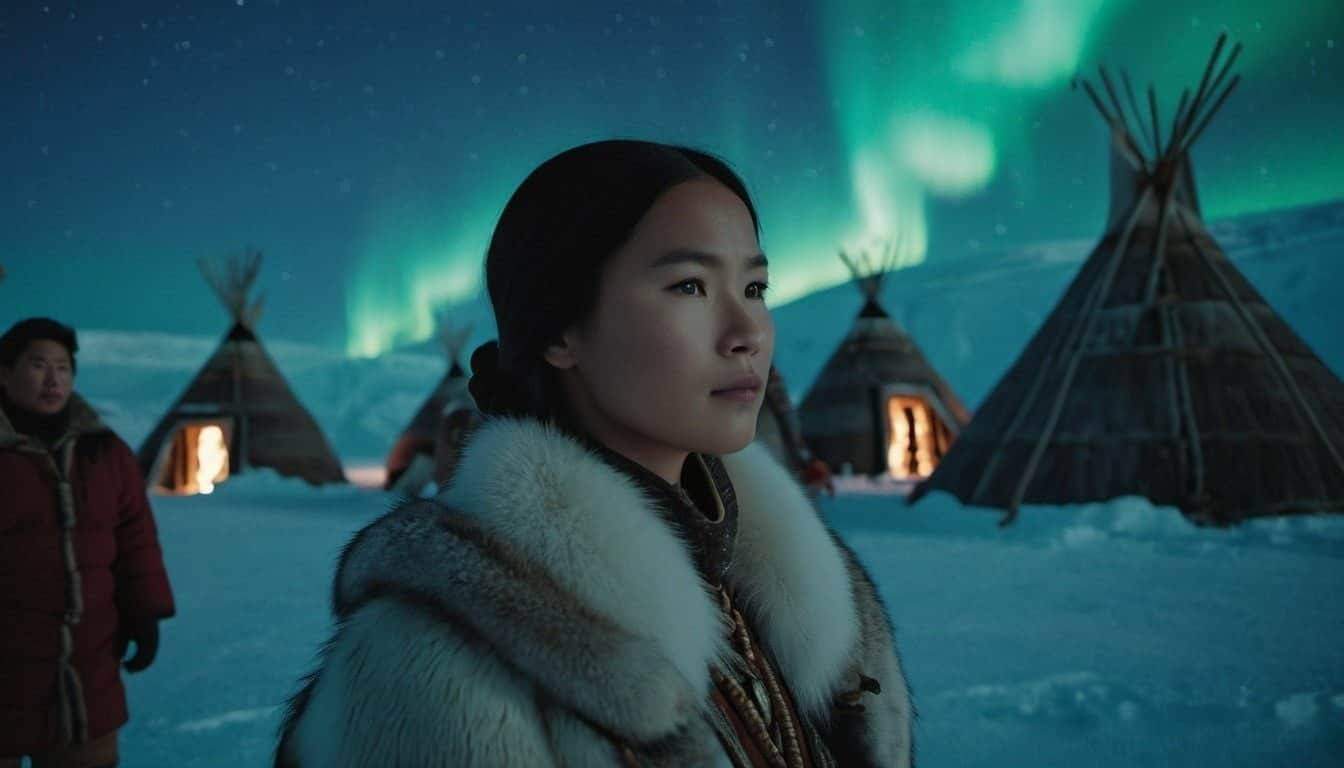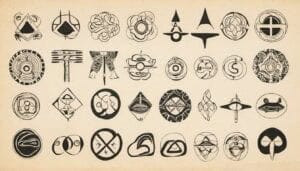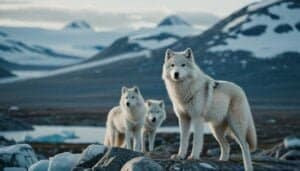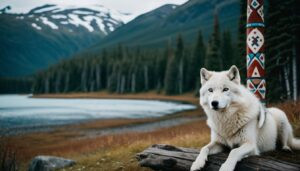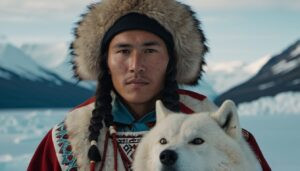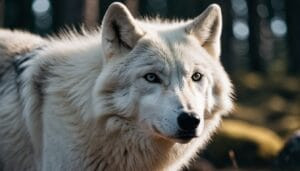Introduction
Arctic wolves hold a significant place in the mythology and culture of Inuit tribes. These majestic creatures are not only symbols of strength and survival but also spiritual guides that bridge the human and natural worlds
Throughout Inuit history, Arctic wolves have been central to various legends, rituals, and artistic expressions. This article delves into the key legends and symbolic roles of Arctic wolves, their spiritual significance, and their enduring influence on Inuit culture and art
Key Legends and Symbolic Roles of Arctic Wolves
Arctic wolves play a prominent role in Inuit mythology, where they are often depicted as powerful and revered beings
These legends and their symbolic meanings reflect the deep connection between the Inuit people and the natural world. Understanding these stories provides insight into the values and beliefs of the Inuit culture
Prominent Myths and Stories
In Inuit mythology, Arctic wolves are frequently featured in tales that emphasize their strength, intelligence, and survival skills
One notable legend is the story of Amarok, a gigantic wolf that roams the Arctic wilderness. Unlike other wolves that hunt in packs, Amarok is a solitary hunter, symbolizing the independent and resilient spirit of the Inuit people
According to the legend, Amarok hunts those who foolishly venture out at night alone, serving as a guardian of the natural order and a deterrent against reckless behavior
Another prominent myth involves the “Wolf Mother” who is said to have raised orphaned Inuit children. This story highlights the nurturing and protective aspects of Arctic wolves, portraying them as caretakers of the vulnerable and embodying the community-oriented values of the Inuit
The Wolf Mother ensures that the children grow strong and capable, teaching them the skills necessary to survive in the harsh Arctic environment
Symbolic Roles in Legends
Arctic wolves are often symbolic of various qualities that are highly valued in Inuit culture. They represent strength, endurance, and adaptability—traits essential for survival in the Arctic’s challenging conditions
Wolves are also seen as spiritual guides, bridging the human and natural worlds. In many legends, wolves are messengers or intermediaries between the physical realm and the spirit world, conveying wisdom and guidance
In addition to their roles as protectors and guides, Arctic wolves symbolize the interconnectedness of all living things. The Inuit believe that every creature has a spirit and a purpose, and wolves, with their keen instincts and survival prowess, exemplify the harmony and balance that is crucial for coexistence in the natural world
Stories Illustrating Strength
Several Inuit stories specifically highlight the strength and bravery of Arctic wolves. One such tale is about a young hunter who encounters a fierce wolf during a hunting expedition. Instead of attacking, the wolf observes the hunter’s actions and, over time, the two develop a mutual respect
The hunter learns from the wolf’s hunting techniques and endurance, which helps him become a better provider for his community. This story underscores the respect and admiration the Inuit have for the wolf’s capabilities and the lessons humans can learn from their animal counterparts
Another story tells of a time when a severe winter threatened the survival of an Inuit village. The people were struggling to find food, and starvation loomed. According to the legend, a pack of Arctic wolves led the hunters to a herd of caribou, ensuring the community’s survival
This narrative emphasizes the idea of wolves as protectors and providers, reflecting the reciprocal relationship between humans and animals in Inuit beliefs
Spiritual Significance of Arctic Wolves in Inuit Beliefs
Arctic wolves hold profound spiritual significance in Inuit beliefs, where they are often seen as guides and protectors in the spiritual realm. The relationship between the Inuit and these majestic creatures extends beyond the physical world, permeating various aspects of spirituality and shamanistic practices
Shamanistic Practices
In Inuit culture, shamans, known as angakkuit, play a crucial role as intermediaries between the human and spirit worlds
Arctic wolves are frequently featured in shamanistic practices, where they are believed to possess powerful spiritual energies. Shamans often seek to connect with the spirit of the wolf to gain strength, wisdom, and protection
During rituals, shamans may wear wolf skins or masks to embody the spirit of the wolf, entering a trance-like state to communicate with the spiritual realm. The wolf’s keen senses and survival skills are thought to be imparted to the shaman, enabling them to navigate the challenges of both the physical and spiritual worlds
These practices highlight the deep respect the Inuit have for the Arctic wolf’s abilities and their belief in the interconnectedness of all beings
Spiritual Symbolism
Arctic wolves are considered symbols of various spiritual qualities in Inuit beliefs. One significant aspect is their role as guides for the souls of the deceased
It is believed that wolves accompany the souls on their journey to the afterlife, ensuring they reach their destination safely. This belief underscores the wolf’s role as a guardian and protector, extending their influence beyond the earthly realm
The Arctic wolf is also seen as a symbol of transformation and renewal. Much like the wolf’s ability to adapt and thrive in the harsh Arctic environment, it is believed that the wolf spirit can help individuals undergo personal transformation and overcome adversity
This symbolism is often reflected in stories where wolves guide individuals through difficult times, helping them emerge stronger and wiser
Rituals and Ceremonies
Various rituals and ceremonies in Inuit culture involve Arctic wolves, celebrating their significance and invoking their spiritual power
One such ceremony is the Wolf Dance, performed to honor the wolf spirit and seek its blessings. Participants in the dance wear wolf costumes and mimic the movements of wolves, creating a powerful connection with the spirit world. The dance is believed to bring strength, courage, and unity to the community, reinforcing the bonds between humans and the natural world
Another important ritual is the wolf naming ceremony, where newborns are given names that reflect the qualities of the Arctic wolf
These names are thought to bestow the child with the wolf’s attributes, such as bravery, endurance, and keen instincts. The ceremony is a way of ensuring that the child grows up with a strong connection to their cultural heritage and the natural world
In addition, healing ceremonies often invoke the spirit of the Arctic wolf. Shamans call upon the wolf’s energy to aid in physical and spiritual healing, drawing on the wolf’s strength and resilience. These ceremonies may involve chanting, drumming, and other traditional practices designed to harness the wolf’s power and channel it towards the healing proces
Arctic Wolves in Inuit Culture and Art
Arctic wolves have left an indelible mark on Inuit culture and art, where they are celebrated for their beauty, strength, and spiritual significance
Their presence is evident in various forms of oral traditions, storytelling practices, and artistic expressions, reflecting the deep connection between the Inuit people and these magnificent creatures
Oral Traditions and Storytelling
The Inuit have a rich oral tradition, where stories about Arctic wolves are passed down through generations. These tales serve not only as entertainment but also as a means of preserving cultural knowledge and values
In many Inuit stories, Arctic wolves are depicted as wise and noble beings. One common narrative involves a wolf that helps a lost hunter find his way home
Through the wolf’s guidance, the hunter learns important lessons about respect for nature and the interconnectedness of all living things. This story underscores the wolf’s role as a guide and protector in Inuit culture
Another prevalent theme in Inuit storytelling is the wolf’s ability to shape-shift. In these tales, wolves can transform into human form and vice versa, symbolizing the fluid boundaries between the human and animal worlds. These stories highlight the belief in the spiritual connection between humans and animals, a central tenet of Inuit cosmology
Artistic Depictions
Arctic wolves feature prominently in Inuit art, which often serves as a visual expression of cultural beliefs and traditions
Traditional carvings, known as scrimshaw, often depict wolves in various poses, capturing their grace and power. These carvings are made from materials like ivory, bone, and antler, and are intricately detailed to reflect the artist’s deep respect for the animal
In addition to scrimshaw, Arctic wolves are also depicted in Inuit masks and sculptures. Masks used in ceremonial dances often feature wolf motifs, representing the animal’s spiritual significance. These masks are typically crafted from wood, animal skins, and other natural materials, and are decorated with fur, feathers, and paint to bring the wolf spirit to life
Sculptures of Arctic wolves are another common form of artistic expression. These sculptures, often made from soapstone or whalebone, depict wolves in dynamic poses, capturing their essence and movement. Artists strive to convey the wolf’s strength and agility, as well as its spiritual importance, through their work
Modern Cultural Preservation Efforts
In recent years, there has been a concerted effort among Inuit communities to preserve and revitalize their cultural heritage, including the stories and artistic traditions involving Arctic wolves
This movement is driven by a desire to maintain a strong cultural identity and pass on important knowledge to future generations
One key aspect of these efforts is the documentation and recording of oral histories. Elders and storytellers are often recorded sharing traditional tales, ensuring that these stories are preserved in their original form. These recordings are then used as educational resources for younger generations, helping them connect with their cultural roots
Artistic workshops and cultural programs also play a crucial role in preserving Inuit traditions. These programs provide opportunities for community members to learn traditional carving, mask-making, and other artistic techniques
By engaging in these practices, participants can develop a deeper appreciation for their cultural heritage and the significance of Arctic wolves in their history
Additionally, cultural festivals and exhibitions celebrate Inuit art and storytelling, providing a platform for artists and storytellers to share their work with a broader audience. These events help raise awareness about the importance of cultural preservation and foster a sense of pride and unity within the community
Human-Animal Relationships in Inuit Mythology
The relationship between humans and animals is a cornerstone of Inuit mythology, with Arctic wolves playing a central role
This connection is deeply rooted in the Inuit understanding of the natural world, where every being has a purpose and a spirit. Arctic wolves symbolize the harmonious coexistence and mutual respect between humans and animals
Connection Through Myths
Inuit mythology is replete with stories that illustrate the profound connection between humans and Arctic wolves. These myths often depict wolves as companions, protectors, and even kin to humans
One such story tells of a hunter who, after saving a wolf pup from a trap, forms a lifelong bond with the animal. The wolf, in turn, helps the hunter during his expeditions, leading him to game and warning him of dangers. This tale highlights the reciprocal relationship between humans and wolves, emphasizing mutual aid and respect
Another myth involves a young Inuit woman who transforms into a wolf to be with her lupine family
This story reflects the belief in the fluidity of identity and the spiritual connection between humans and animals. It underscores the idea that humans and wolves share common traits and can learn from each other, fostering a deeper understanding and appreciation for the natural world
Unique Roles of Arctic Wolves
Arctic wolves occupy a unique place in Inuit mythology, distinct from other animals. They are often seen as mediators between the human and spiritual realms, possessing qualities that allow them to navigate both worlds
Unlike other animals, wolves are believed to have a heightened sense of awareness and intelligence, making them ideal guides and protectors
Wolves are also viewed as symbols of endurance and survival, traits highly valued in the harsh Arctic environment. Their ability to thrive in extreme conditions is seen as a testament to their strength and resilience. This symbolism is reflected in stories where wolves help humans overcome adversity, teaching them valuable lessons about perseverance and adaptability
Comparative Analysis with Other Animals
While Arctic wolves hold a special place in Inuit mythology, other animals also feature prominently in their stories. Comparing wolves to other animals can provide insight into the unique roles each species plays in Inuit culture
For instance, raven is another significant animal in Inuit mythology, often depicted as a trickster and creator figure. Unlike the wolf, which symbolizes strength and guidance, the raven represents cunning and transformation
Both animals are revered for their intelligence, but their roles in mythology highlight different aspects of human experience—raven’s cleverness and adaptability versus the wolf’s strength and loyalty
Bears are also important in Inuit mythology, symbolizing power and protection. While bears, like wolves, are seen as guardians, their portrayal is often more solitary and focused on brute strength. In contrast, wolves are depicted as social animals, emphasizing community and cooperation
This distinction reflects the different ways in which these animals are perceived and the lessons they impart to the Inuit people
Whales, particularly the bowhead whale, hold a special place in Inuit culture as symbols of abundance and sustenance. Whales are revered for their size and the resources they provide, but they are not typically associated with the same level of spiritual guidance as wolves
The wolf’s role as a guide and protector sets it apart from other animals, highlighting its unique significance in Inuit mythology
Conclusion
Arctic wolves hold a profound and multifaceted place in Inuit mythology and culture, symbolizing strength, endurance, and spiritual guidance. These majestic creatures are central to many Inuit legends, where they are depicted as protectors, guides, and symbols of survival
The connection between humans and Arctic wolves is deeply ingrained in the oral traditions, storytelling practices, and artistic expressions of the Inuit people, reflecting a harmonious relationship that extends beyond the physical world
Through shamanistic practices, spiritual symbolism, and various rituals, Arctic wolves are celebrated for their spiritual significance. They are seen as intermediaries between the human and spirit worlds, guiding souls, aiding in personal transformations, and playing a crucial role in healing ceremonies
These practices highlight the deep respect the Inuit have for the Arctic wolf’s abilities and their belief in the interconnectedness of all beings
The influence of Arctic wolves is also evident in Inuit art and culture. From intricate carvings and sculptures to masks and modern cultural preservation efforts, the Arctic wolf’s presence is a testament to its enduring importance. The Inuit continue to honor and preserve the stories and artistic traditions involving Arctic wolves, ensuring that their legacy endures for future generations.
Finally, the relationship between humans and Arctic wolves in Inuit mythology underscores the values of mutual respect and coexistence
Through comparative analysis with other animals in Inuit myths, we see the unique roles each species plays in conveying cultural values and lessons. Arctic wolves, with their strength, loyalty, and spiritual significance, hold a special place that sets them apart, highlighting their unique contribution to the rich tapestry of Inuit beliefs and traditions
